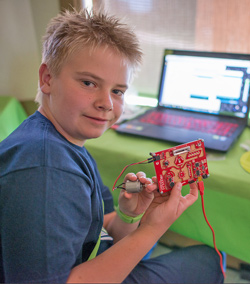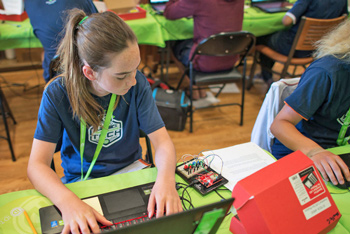SparkFun Stories of Success
Understand the How and Why of Technology
Alycia Meier, Curriculum Development and Education Hardware Specialist for iD Tech
iD Tech, Campbell, CA
Getting kids interested in not only what you can do with tech but also how and why it works can be a challenge.
The future depends on a tech-literate generation, and by the time today’s children and teens join the workforce, few jobs will exist in the global economy that don’t require some familiarity with electronics or electronics concepts. Solutions to the world’s needs will be based on technological advances, and the earlier students are inspired with curiosity and confidence in working with technology, the better.

“The maker movement is extremely important to this generation; slowly, over the past few decades, we’ve become consumers instead of creators,” says Alycia Meier, curriculum development and education hardware specialist for iD Tech. “With pollution, climate change and the need for clean energy, we have to create a generation that has the tools needed to address the problems with which they’ll be faced.”
In the 18 years since its inception in a garage overlooking Silicon Valley, iD Tech has grown exponentially, each year providing nearly 100,000 kids ages 6–18 unparalleled STEM education by blending traditional summer camps with cutting-edge technology programs and experiences. Their goal? Inspire the next generation of tech innovators and visionaries. They’ve been remarkably successful — today iD Tech has 100+ camp locations with over 1500 students taking a course.
Programs like iD Tech, with such a large reach and ambitious mission, face a unique challenge: how to maximize their ability to supply camps and thousands of students with hands-on STEM learning materials that are both resilient and relevant for years on end. SparkFun’s kits and resources fit the bill with a standardized format that’s easy to adapt to different ages, interests and skill levels.
“Parents had been asking for courses that allowed students to take apart clocks, radios and other electronics to learn how they work on the inside,” Meier says. “We wanted something that students could explore in a safe and educational format. We started with one course using the SparkFun Inventor’s Kit [SIK] v3.3, and it was so popular that we now run multiple courses: we use the SIK for Photon for our 13- to 17-year-olds, the Digital Sandbox for the 10- to 12-year-olds and the LilyPad Arduino for our 10- to 15-year-olds at Alexa Café.”
“Teaching this course can sometimes be difficult, not because the material is hard to learn, but because the students can’t get enough of it. We have to make sure our students actually take breaks; they will pretend to play Minecraft, and then we’ll see them wiring their LEDs to a breadboard.”
In addition to a stable learning environment, kits like the SIK offer the flexibility for students to build on the basics, using their own creativity to come up with new project ideas. Teaching with electronics is also a way to encourage kids to connect concepts that may seem intimidating with hands-on examples, often leading them to branch out into topics they may not have previously expressed interest in.
“Writing code can feel so abstract at first, so adding a maker element makes coding tangible,” says Meier. “It allows students to be creative in new and exciting ways. When we first added the LilyPad Arduino, which is a wearable Arduino board, we had a surge in course registrations. Students said it made code more hands-on and creative, and now it’s fun!”
Meier is continually impressed with the capabilities of her students once they’re given the skills and confidence to experiment with the kits and materials on their own.

“Our students are so creative; we teach them how to program a motor, and they make a windmill for a mini-golf course,” she says. “Another used the LilyPad Arduino kit to program a Vibe motor to simulate a heartbeat. Using the SIK for Photon, another student measured water tables to better record live data on flooding and droughts.”
That, after all, is the goal: to give the next generation of problem-solvers the knowledge they need to understand how this tech fits into their lives, and let their enthusiasm and creativity take them from there. Ultimately, that spark of inspiration will grow into the passion and ability to create real solutions for themselves and the world around them.
“The students want to make an impact, and it’s really important as educators that we go beyond metrics and standards since these students will be creating our future standards,” Meier says. “Start small — attach an LED to a battery, then give the students some copper tape or wires and tell them they can make anything they want. Once you’ve piqued their interest, give your students real-world challenges based on current events. That’s where innovation comes from.”
Q & A
Which SparkFun products or services are used in your program? How did this collaboration come about, and what motivated you to add our products to your camps?
Parents had been asking for courses that allowed students to take apart clocks, radios and other electronics to learn how they work on the inside. We wanted something that students could explore in a safe and educational format, but also a project they could keep at the end of camp. We started with one course using the SparkFun Inventor’s Kit v3.3, and it was so popular that we now run multiple courses: we use the SIK for Photon for our 13- to 17-year-olds, the Digital Sandbox for the 10- to 12-year-olds and the LilyPad Arduino for our 10- to 15-year-olds at Alexa Café.
What was the biggest obstacle you faced in incorporating these materials?
A maker-type course uses a lot of consumable material, which is easy to source for a classroom of 30, but when you have 100+ camp locations with more than 1,500 students taking a course, there’s a lot of planning involved. Not only do we use the kits provided by SparkFun, but we also have to make a classroom kit with different types of LEDs, sensors and breadboards to cater to different student interests and learning types.
Teaching this course can sometimes be difficult, not because the material is hard to learn, but because the students can’t get enough of it. We have to make sure our students actually take breaks; they will pretend to play Minecraft, and then we’ll see them wiring their LEDs to a breadboard. Programming a motor to spin and connecting LEDs to potentiometers is fun!
How do you implement maker education — is it supplemental to core content, part of an engineering class, an open lab…?
It’s a core element of our engineering courses. The maker movement is extremely important to this generation; slowly, over the past few decades, we’ve become consumers instead of creators. With pollution, climate change and the need for clean energy, we have to create a generation that has the tools needed to address the problems with which they’ll be faced.
What do you like most about incorporating SparkFun’s products into your camps?
Writing code can feel so abstract at first, so adding a maker element makes coding tangible. Students code a motor to spin or a buzzer module to play the music they write. They build a music box, a pet feeder, an arcade machine only 10" tall or a lock mechanism only opened by problem-solving. It allows students to be creative in new and exciting ways.
What has been the reaction from students toward the kits?
Children experience creativity in ways that we forget about as adults. For example, we taught a class of students how to create a light switch; it was a simple mechanism with a slide switch wired to an LED. The purpose was to show our students how everyday objects they interact with are made. When letting the class explore the lesson how they wanted, we found them creating a long-distance light switch that would turn on an LED on a friend’s breadboard farther away. They wanted to make something that reminded a friend that they were thinking about them.
How did you prepare students for these materials? What surprised you about students’ reactions or ingenuity?
We had to prepare our instructors more than the students. We found after our first session that instructors had to bring out different materials slowly over the week. If they didn’t, students were getting into everything, wanting to explore it all at once and too excited to go home.
How has maker education changed the way students learn?
We’ve had some students who weren’t as interested in coding; they thought it would be too boring, so they avoided it and stuck with video and game design courses. When we first added the LilyPad Arduino, which is a wearable Arduino board, we had a surge in course registrations. Students said it made code more hands-on and creative, and now it’s fun!
What kinds of projects are your students working on? What problems or triumphs have they had? Any projects that impressed you in particular?
Our students are so creative; we teach them how to program a motor, and they make a windmill for a mini-golf course. Another used the LilyPad Arduino kit to program a Vibe motor to simulate a heartbeat. They sewed it into a stuffed animal they designed to donate to children in hospitals. Using the SIK for Photon, another student measured water tables to better record live data on flooding and droughts.
What would be your advice for other educators wanting to get into maker education?
The students want to make an impact, and it’s really important as educators that we go beyond metrics and standards since these students will be creating our future standards. Start small — attach an LED to a battery, then give the students some copper tape or wires and tell them they can make anything they want. You don’t have to get fancy with materials; teach the students how to prototype with cardboard and tape. Once you’ve piqued their interest, give your students real-world challenges based on current events. If you’re not sure what maker materials you need, ask the students! They may want materials you never even thought to try. That’s where innovation comes from.